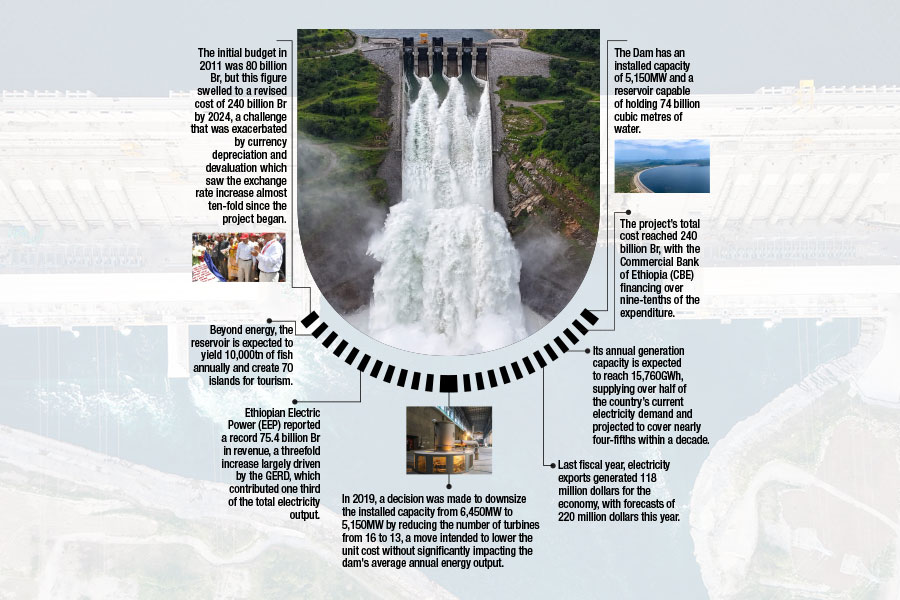
Viewpoints | Aug 09,2025
Dec 25 , 2021
By Mikael Alemu
Every kid in my school was educated about love. Our teachers explained it in great detail. First graders shared the same knowledge as graduates. We were told that there are only two kinds of love: love for our country and for the communist party. Our love did not save the communist party of the Soviet Union. I want to talk about the love of the country.
The most important thing about love is that true love expresses itself through action. It means nothing if we do not act on it. If we love our country, we must act. If we love Ethiopia, we must make it safe, prosperous and abundant.
I was told in a business school that every development plan starts with a reality check. We must have an honest and clear evaluation of our economic reality, and there is a straightforward metric that helps here: energy consumption. Scientists such as Vaclav Smil have demonstrated a strong correlation between energy consumption and economic growth.
Ethiopian energy consumption is estimated at 324 thousand terajoules a year. This is less than the consumption of England in 1809 (518 thousand terajoules) and six times less than modern Nigeria (1747 thousand terajoules). If anyone thinks that the level of energy consumption in Nigeria is high, I suggest they think again as Nigeria consumes less energy than England did in 1859 (1835 thousand terajoules). Several economists suggest that Ethiopia shall benchmark its development against the South East Asian nation of Vietnam, which consumes 3922 thousand terajoules – ten times more than we do.
What had happened in England between 1809 and 1859?
First, the industrial revolution happened, with a substantial increase in productivity and energy density. The textile industry was created and employed millions of people. Chemicals were introduced for industrial manufacturing of glass, textile and iron. Industrial production of paper has led the way for mass education. Portland cement was invented, and the construction industry was born. Street lighting emerged together with the infrastructure for gaslighting. The change was immense, supported by a three-fold increase in energy generation.
One shall not forget the tremendous humanitarian cost of the first industrial revolution. Working conditions were terrible and often deadly, especially for ironworkers and coal miners. Much of the labour was unskilled. Children as young as eight worked in textile mills and helped in mines. Living conditions were poor. People moved into urban areas so rapidly that there was not enough capital to build adequate housing for everyone. So, low-income newcomers squeezed into increasingly overcrowded slums. Clean water, sanitation, and public health facilities were inadequate. The death rate was high, especially infant mortality and tuberculosis among young adults. Cholera from polluted water and typhoid were endemic.
Nature was badly hurt. Heavy air pollution from factories and broken land at coal mines have contributed to the enormous devastation of natural resources. Rivers were polluted by chemical factories, lighting gas manufacturers and human waste.
If we love our country, we want it to enjoy the fruits of the industrial and agricultural revolution, the abundance of cheap products and food items, have wealthy and happy people, healthy and educated kids, abundant energy supply and constant innovations.
At the same time, nobody wants a beloved country to go through the pain and devastation caused by the England-style industrial revolution (or China-style, for that matter). We must find ways to develop Ethiopia's economy and not cause damage to our people, natural resources and land. The world has shown us a way to achieve this goal.
The solution is called ‘sustainable development.’ An important part of this approach is renewable energy - energy production without nature's destruction. Solar energy (my favourite kind of renewable) produces zero grams of carbon dioxide, thus protecting the climate. It does not require depletion of natural resources and does not harm people's health, unlike diesel generation that is deadly and criminal.
Solar-powered Ethiopia that produces 30 to 50 gigawatts of electricity will be an industrial country with a robust agricultural sector that will meet the domestic demand and export its produce. Energy-abundant Ethiopia will manufacture its own machinery, give universal education to children and maintain a high living standard for every citizen.
PUBLISHED ON
Dec 25,2021 [ VOL
22 , NO
1130]


Viewpoints | Aug 09,2025

Radar | Aug 31,2019

Fortune News | Sep 13,2025

Life Matters | Mar 12,2022

Sunday with Eden | Aug 01,2020

Radar | Feb 10,2024

Commentaries | Nov 12,2022

Viewpoints | Apr 13, 2025

Viewpoints | Apr 19,2025

Fortune News | Jul 17,2022

Photo Gallery | 178771 Views | May 06,2019

Photo Gallery | 168968 Views | Apr 26,2019

Photo Gallery | 159812 Views | Oct 06,2021

My Opinion | 137111 Views | Aug 14,2021
Commentaries | Oct 25,2025

Dec 22 , 2024 . By TIZITA SHEWAFERAW
Charged with transforming colossal state-owned enterprises into modern and competitiv...

Aug 18 , 2024 . By AKSAH ITALO
Although predictable Yonas Zerihun's job in the ride-hailing service is not immune to...

Jul 28 , 2024 . By TIZITA SHEWAFERAW
Unhabitual, perhaps too many, Samuel Gebreyohannes, 38, used to occasionally enjoy a couple of beers at breakfast. However, he recently swit...

Jul 13 , 2024 . By AKSAH ITALO
Investors who rely on tractors, trucks, and field vehicles for commuting, transporting commodities, and f...

Oct 25 , 2025
The regulatory machinery is on overdrive. In only two years, no fewer than 35 new pro...

Oct 18 , 2025
The political establishment, notably the ruling party and its top brass, has become p...

Oct 11 , 2025
Ladislas Farago, a roving Associated Press (AP) correspondent, arrived in Ethiopia in...

Oct 4 , 2025
Eyob Tekalegn (PhD) had been in the Governor's chair for only weeks when, on Septembe...

Oct 25 , 2025 . By YITBAREK GETACHEW
Officials of the Addis Abeba's Education Bureau have embarked on an ambitious experim...

Oct 26 , 2025 . By YITBAREK GETACHEW
The federal government is making a landmark shift in its investment incentive regime...

Oct 29 , 2025 . By NAHOM AYELE
The National Bank of Ethiopia (NBE) is preparing to issue a directive that will funda...

Oct 26 , 2025 . By SURAFEL MULUGETA
A community of booksellers shadowing the Ethiopian National Theatre has been jolted b...